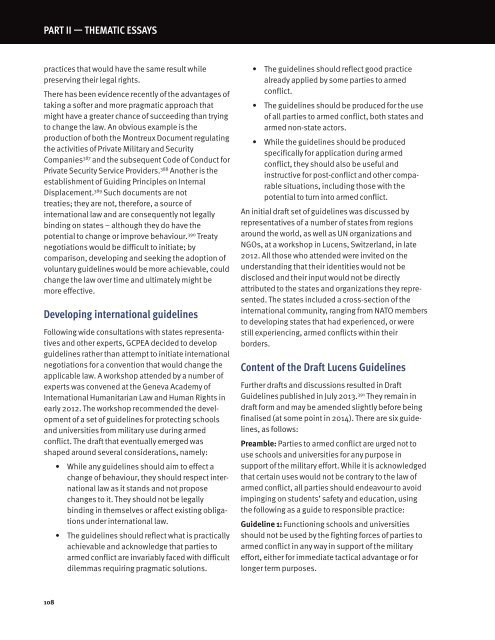Create successful ePaper yourself
Turn your PDF publications into a flip-book with our unique Google optimized e-Paper software.
PART II — THeMATIC eSSAYS<br />
practices that would have the same result while<br />
preserving their legal rights.<br />
There has been evidence recently of the advantages of<br />
taking a softer and more pragmatic approach that<br />
might have a greater chance of succeeding than trying<br />
to change the law. An obvious example is the<br />
production of both the Montreux Document regulating<br />
the activities of Private Military and Security<br />
Companies 387 and the subsequent Code of Conduct for<br />
Private Security Service Providers. 388 Another is the<br />
establishment of Guiding Principles on Internal<br />
Displacement. 389 Such documents are not<br />
treaties; they are not, therefore, a source of<br />
inter national law and are consequently not legally<br />
binding on states – although they do have the<br />
potential to change or improve behaviour. 390 Treaty<br />
negotiations would be difficult to initiate; by<br />
comparison, developing and seeking the adoption of<br />
voluntary guidelines would be more achievable, could<br />
change the law over time and ultimately might be<br />
more effective.<br />
Developing international guidelines<br />
Following wide consultations with states representatives<br />
and other experts, GCPEA decided to develop<br />
guidelines rather than attempt to initiate international<br />
negotiations for a convention that would change the<br />
applicable law. A workshop attended by a number of<br />
experts was convened at the Geneva Academy of<br />
International Humanitarian Law and Human Rights in<br />
early 2012. The workshop recommended the development<br />
of a set of guidelines for protecting schools<br />
and universities from military use during armed<br />
conflict. The draft that eventually emerged was<br />
shaped around several considerations, namely:<br />
• While any guidelines should aim to effect a<br />
change of behaviour, they should respect international<br />
law as it stands and not propose<br />
changes to it. They should not be legally<br />
binding in themselves or affect existing obligations<br />
under international law.<br />
• The guidelines should reflect what is practically<br />
achievable and acknowledge that parties to<br />
armed conflict are invariably faced with difficult<br />
dilemmas requiring pragmatic solutions.<br />
• The guidelines should reflect good practice<br />
already applied by some parties to armed<br />
conflict.<br />
• The guidelines should be produced for the use<br />
of all parties to armed conflict, both states and<br />
armed non-state actors.<br />
• While the guidelines should be produced<br />
specifically for application during armed<br />
conflict, they should also be useful and<br />
instructive for post-conflict and other comparable<br />
situations, including those with the<br />
potential to turn into armed conflict.<br />
An initial draft set of guidelines was discussed by<br />
representatives of a number of states from regions<br />
around the world, as well as UN organizations and<br />
NGOs, at a workshop in Lucens, Switzerland, in late<br />
2012. All those who attended were invited on the<br />
understanding that their identities would not be<br />
disclosed and their input would not be directly<br />
attributed to the states and organizations they represented.<br />
The states included a cross-section of the<br />
international community, ranging from NATO members<br />
to developing states that had experienced, or were<br />
still experiencing, armed conflicts within their<br />
borders.<br />
Content of the Draft Lucens Guidelines<br />
Further drafts and discussions resulted in Draft<br />
Guidelines published in July 2013. 391 They remain in<br />
draft form and may be amended slightly before being<br />
finalised (at some point in 2014). There are six guidelines,<br />
as follows:<br />
Preamble: Parties to armed conflict are urged not to<br />
use schools and universities for any purpose in<br />
support of the military effort. While it is acknowledged<br />
that certain uses would not be contrary to the law of<br />
armed conflict, all parties should endeavour to avoid<br />
impinging on students’ safety and education, using<br />
the following as a guide to responsible practice:<br />
Guideline 1: Functioning schools and universities<br />
should not be used by the fighting forces of parties to<br />
armed conflict in any way in support of the military<br />
effort, either for immediate tactical advantage or for<br />
longer term purposes.<br />
108



